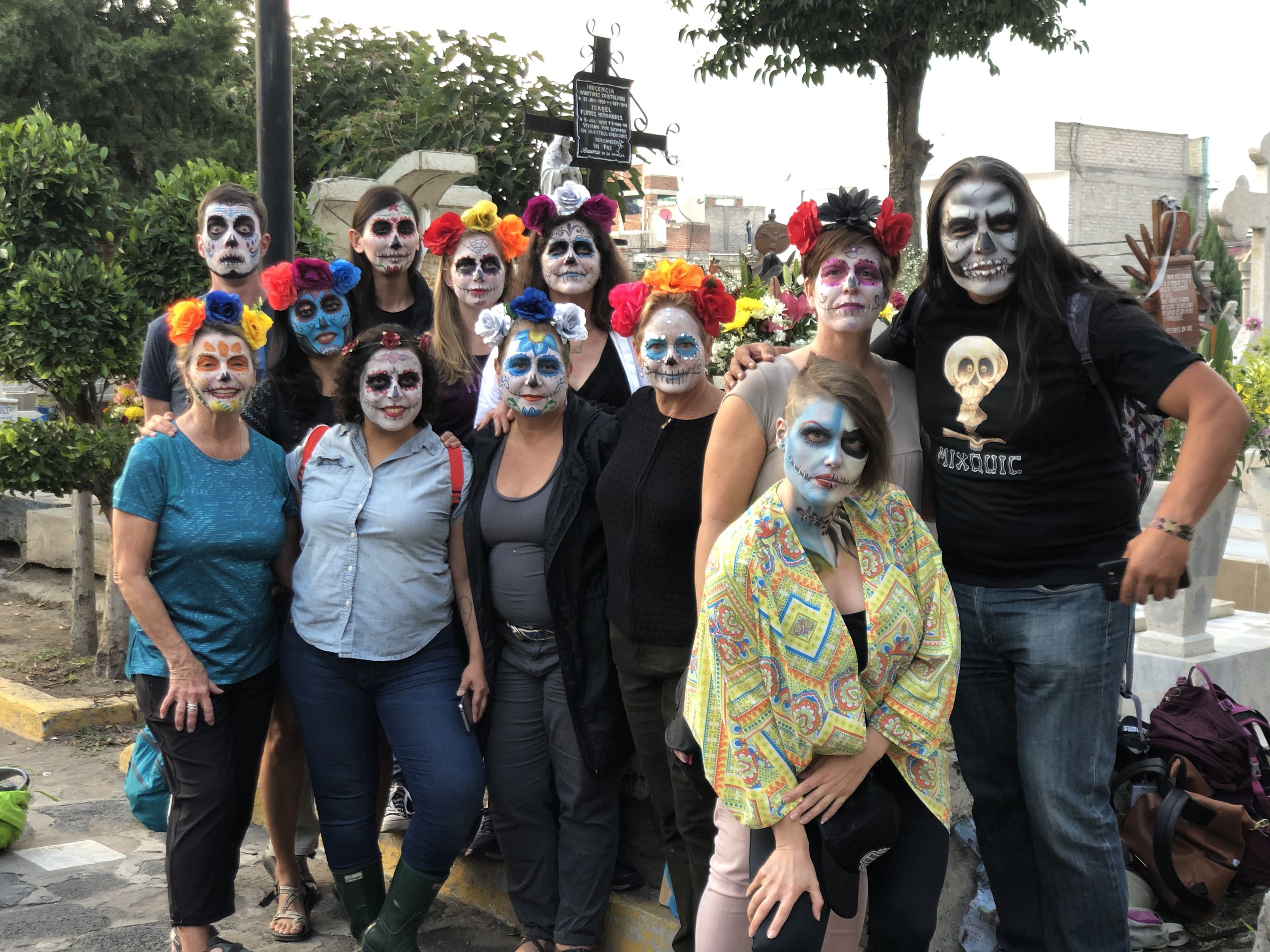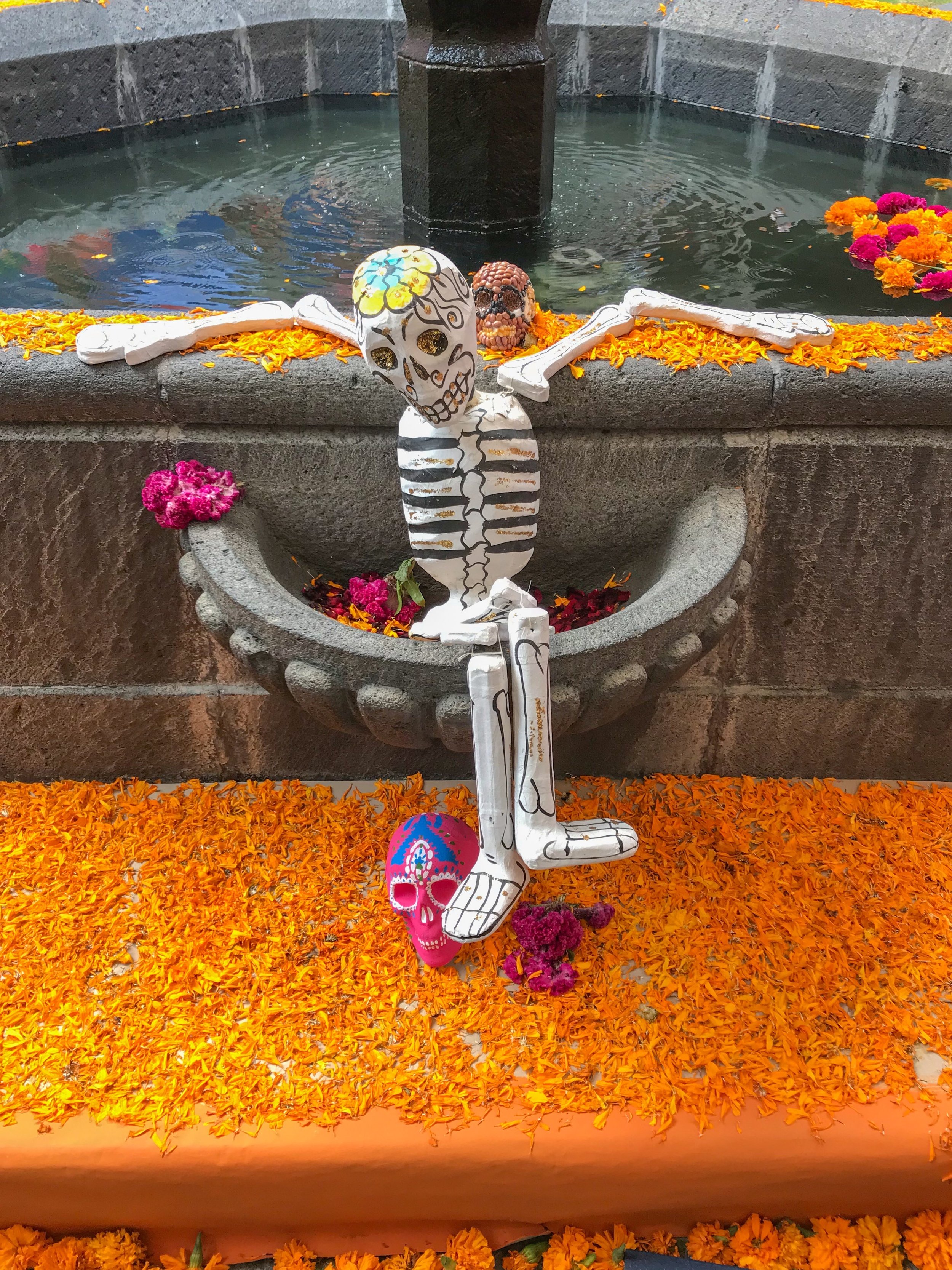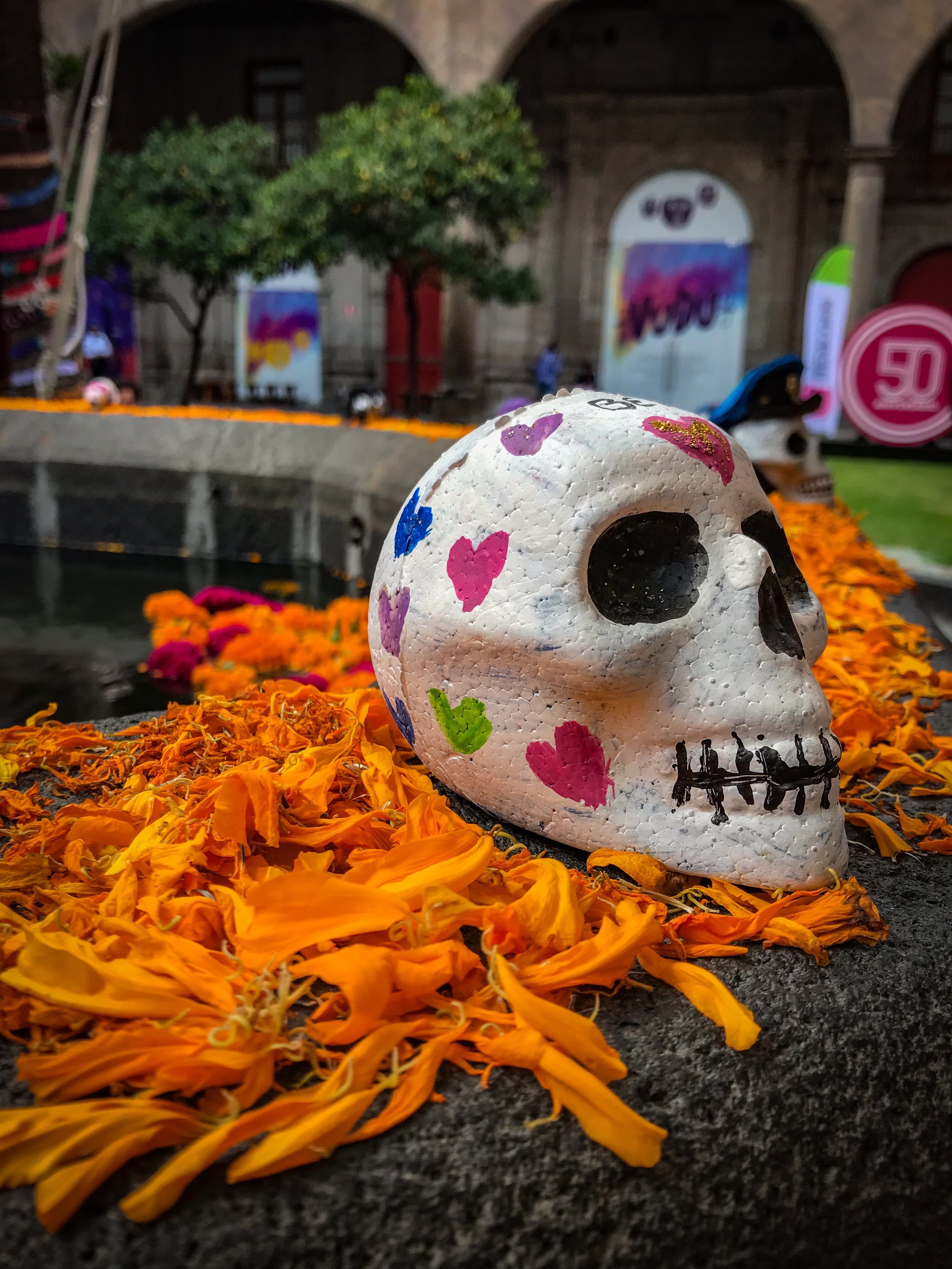Where to go in Mexico for Day of the Dead
Where to go in Mexico for Day of the Dead
Day of the Dead in Mexico is a once-in-a-lifetime opportunity and given the country’s large size, you have a lot of options for where to go in Mexico for Day of the Dead. Mexico is also a hugely diverse country in terms of landscape, climate, geography, food, music, and tradition so when choosing where to go in Mexico for Day of the Dead, also consider what else you want to do during your trip. Day of the Dead in Mexico City and Oaxaca are two popular (and excellent) options but they’re far from your only choices. You can also choose between planning your own trip and joining a Day of the Dead group tour if you prefer someone else handle all the details.
Leading up to Dia de los Muertos, you’ll see ofrendas, sugar skulls, and marigold (cempasuchil) flowers decorating streets and store windows throughout Mexico, and pan de muertos (“dead bread”) in bakeries across the country. The largest Day of the Dead celebrations are usually held around a city’s historic center or main square, where you’ll likely find large Day of the Dead-themed art installations. Families also build ofrendas in their own homes and decorate the graves of loved ones with marigold flowers, candles, and photographs in the cemetery (also known as a panteón).
Day of the Dead in Mexico is celebrated on November 1 and 2 each year but you’ll want to arrive at least a few days early to enjoy events leading up to the main celebration. Regardless of where you go in Mexico for Day Day of the Dead, you’re pretty much guaranteed to have a great time and you can even work in daytrips to other cities and sites. So pack your bags with a few key travel items, read up on travel insurance for Mexico, and use the travel tips below to get you started on your planning journey. Ole!
Day of the Dead Mexico City
The Mexico City Day of the Dead parade has dramatically increased interest in celebrating Day of the Dead in Mexico City among travelers from the United States and Canada and you can even join a Mexico City Day of the Dead Parade group tour. However, know that there is far more to Day of the Dead in Mexico City than the James Bond film-inspired parade, which only started in 2016, and usually occurs a week before Day of the Dead. As the country’s largest city, you’ll find some of the biggest and the best Day of the Dead decorations and celebrations here. Massive Day of the Dead arts installations occupy the main square, elaborate decorations take over museums and galleries, and if you want to attend evening cemetery celebrations, you have your pick from large and small.
As one of the largest cities in the world, Day of the Dead in Mexico City also means you’ll get to enjoy everything else the city has to offer, from world-class restaurants, incredible museums like Frida Kahlo’s Blue House, easy access to the pyramids at Teotihuacan, and Mexico City’s world-famous Ballet Folklórico de México at the fine arts palace.
Mexico City is a pretty safe city and experienced travelers should be able to make their way around just fine, particularly if they speak some Spanish, have an international data plan, and an adventurous spirit. If you feel safer in a group - or if you’d simply prefer to relax and not have to worry about any pesky details or difficult logistics - the EscapingNY Mexico City Day of the Dead small group tour is a great option for travelers who want to be fully immersed in Day of the Dead culture but who are also interested in food tasting tours; guided visits to food, flower, and witchcraft markets; bike rides through diverse neighborhoods (on protected bike lanes); and the option to visit Frida Kahlo’s home without spending several hours in line (which is what most solo travelers wind up doing).
One of my Day of the Dead group tours in Mexico City
Traditional Day of the Dead altar
Day of the Dead Oaxaca
After Mexico City, Oaxaca (pronounced “wah-HAH-kah” emphasis on the “HAH”) is probably the most famous destination for Day of the Dead in Mexico. The city is much smaller than Mexico City but the Day of the Dead celebrations are huge and you can also enjoy the quaint and historic feel that much of the city has to offer. Like other cities, you’ll find the biggest Day of the Dead celebrations in Oaxaca in the histotic center. Think Day of the Dead parade (on a smaller scale), face paint, papel picada (traditional cut paper), crosses, candles, altars, and flowers. You can plan your own visit or join a Day of the Dead group trip to Oaxaca.
Just like in other cities, Day of the Dead in Oaxaca is a festive celebration, not a somber day of sadness. Multi-tiered altars are decorated with pictures of the deceased, sugar skulls, candles, crosses, and flowers and you also find fruits, nuts, pan de muertos bread, and foods that the deceased person would have enjoyed during their life. You’ll also find Oaxaca-specific items like chocolate and mole on the altars.
Arrive a few days early for Day of the Dead in Oaxaca so you have time to visit the Cathedral (a block from the bustling zócalo), the Mercado Benito Juarez, and attend the Magna Comparsa (Grand Parade), which kicks off Dia de los Muertos celebrations on October 31st. During the day and into the early evening, visit the Panteón General de San Miguel and look out for comparsas parades. At night, you’ll also find wild parties in nearby San Agustin Etla (about 30 minutes from Oaxaca City by taxi), with marching bands and elaborate costumes. Within Oaxaca, you can also do fun activities like a taking a Oaxacan cooking class or Oaxaca street food tour or doing a daytrip to Monte Albán, or to Hierva el Agua, a mezcal distilery and Mitla.
The Oaxaca region is known for its historical sites of Monte Albán and Mitla, and for its indigenous cultures, like the Mixtecs and Zapotecs (who you can support by purchasing handmade food goods they sell). While the biggest Day of the Dead celebrations in Oaxaca (the state) are held in Oaxaca (the city), if you already came this far, consider flying to Oaxaca’s Pacific coast, which is lined with beaches and is known for world-class surfing. In the seaside town of Puerto Escondido, you can join a dolphin watching tour or a bio-luminescent lagoon tour.
Day of the Dead in Michoacan
Michoacán might be best known to international travelers as the place to witness the impressive annual butterfly migration but it’s also one of the best places in Mexico for Day of the Dead. About a four-hour drive from Mexico City, Michoacán is known for its traditional Spanish colonial towns and the historic center of Morelia was declared a UNESCO World Heritage Site in 1991 due to the town’s well-preserved colonial buildings.
During Day of the Dead in Michoacán, copal incense is burned throughout homes and in the streets, as it’s used to purify the air, while trails of orange marigold and magenta-colored cockscomb flowers and petals blanket the streets to help the dead find their way back from the spirit world. As the dead are believed to consume the essence of the ofrenda offerings, giving them strength after their journey, families prepare food together and place it on altars and bring it to the graves of deceased loved ones.
The Michoacán towns of Pátzcuaro and Tzintzuntzan have been designated as Pueblos Magicos by the federal Secretary of Tourism and they are excellent places to go for Day of the Dead in Mexico. During the day, you can explore the colonial town, enjoy the city-wide Day of the Dead-themed art, or attend a distinguished speaker series, traditional music concert, or folkloric dance performance. At night, you can join a Morelia tour, such as the nighttime (trolley) tour that shares local legends and ghost stories about the buildings in downtown Morelia, or head to Lake Pátzcuaro, about 45 minutes away for even more celebrations.
Day of the Dead in Cancún
Is Cancún the best place for Day of the Dead in Mexico? No, it’s not. The celebrations aren’t nearly as big and the city has a much more touristy feel than Day of the Dead celebrations elsewhere in Mexico. That said, if you’re heading to Cancún for other reasons (like their world-famous beaches, swimming with whale sharks, or visiting their jaw-dropping resorts and incredible nightlife), know that it is still possible to get a Day of the Dead experience. You’ll find cempasuchil (marigold) flowers all over town, along with sugar skulls, elaborate ofrendas and the other sorts of decorations that are traditional during Day of the Dead.
The best place for Day of the Dead in Cancún is around the city’s main square, where you’ll find costume competitions, free concerts, parades, altars, papel picada, hanging decorations in the air and sand tapestries on the ground. Known as tapetes de arena, sand tapestries are a staple during Day of the Dead across Mexico, and they' are basically ground murals made out of colored sand to create detailed scenes with skeletons and saints Some tapestries are also made out of rice, seeds, flowers, and dried beans. When I attended Day of the Dead in Cancún I’ll admit that my favorite part was the large number of incredible street food vendors that had assembled around the main square activities to feed the masses.
While you’re in Cancún, it’s an absolute MUST to visit Mayan ruins and cenote swimming holes. If you don’t rent a car (which can be expensive and difficult), join a daytrip to Chichen Itza, Valledolid, and cenotes.
Day of the Dead in Tijuana
Like Cancún, Tijuana is probably not the best place in Mexico for Day of the Dead but, again, if you’re going there for other reasons (it’s known for its food and nightlife), you can also get in some cultural fun. Tijuana is also much easier to get to from the United States and when I visited Tijuana for Day of the Dead, I simply took the trolley down from San Diego (which took about 30 minutes) then crossed the border by foot. I also biked down from San Diego another time and rode around the area. Regardless how you get there, consider doing a tour, or even a daytrip to do a guided tour of Tijuana and the border area or a wine tasting in the Guadeloupe Wine Valley.
Day of the Dead in Tijuana feels somewhat like Day of the Dead celebrations in the United States, simply because the city has much more of an American influence than other Mexican cities, but you’ll still find all the traditional Day of the Dead decorations (altars, flowers, etc.) and the food is way better than anything you’ll encounter north of the border. Look out for parades of students dressed as catrinas and catrines (elegant skeletons), and know that some of the costume competitions and traditional dances take place not in the main square and parks, but inside shopping malls. To find some of these activities, ask around or follow the music.
Just like everywhere else in Mexico, families flock to cemeteries to spend time with their loved ones but since Tijuana isn’t the most famous destination for Day of the Dead in Mexico, it’s a much smaller spectacle and you won’t encounter the same crowds. When I was there, I encountered only a few families one early evening and one of them had hired a mariachi band to play for their deceased loved ones.
What to know before going to Mexico for Day of the Dead
Be respectful. This may be a bucket list vacation for you but Day of the Dead is a sacred holiday for many Mexicans. Do not step on graves or push people out of the way to “get a good shot” and ask permission before taking photographs of people.
Tip well. Not only do staff in restaurants and hotels earn their living off tips in Mexico, but the people you see dressed up in very elaborate Day of the Dead costumes have spent a tremendous amount of money on their outfit and it is customary to tip them if you take a picture.
Get your face painted at the event. There’s been some discussion about whether it’s okay for a non-Mexican person to have their face painted but every single Mexican I’ve ever encountered during six years of leading Day of the Dead tours in Mexico, has enthusiastically supported the practice. They love seeing foreigners get involved in the event and paying local artists to paint your face at the parade or cemetery is an important source of income for locals so feel good about getting your face painted at the event.
Food poisoning is a real concern in Mexico, and while it’s possible to avoid it and nobody on any of my Mexico group tours has ever gotten sick, it’s important to read up on how to NOT get sick in Mexico.
If you’ve read my post Why You Should Buy Travel Insurance, you’ll know that I’m a huge fan of travel insurance, and of World Nomads, in particular. Travel insurance is an important part of any trip abroad and could come in very handy if things in Mexico don’t go exactly as planned. After all, nobody ever plans to get sick, lose their phone, have the airline lose their luggage, or miss their flight and having comprehensive travel insurance (not the very narrow policy airlines sell) is key to having a great trip.
I’m currently working on a separate article about how to pack for a trip to Mexico but know that you should bring lots of sunblock and wear sun-protective clothing. It’s cool in the evening so you’ll want to pack layers (I tend toward breathable products that are multi-purpose). You can find a list and description of my favorite products in my Travel Store.
Should you join a Day of the Dead tour or go alone?
Well, that’s up to you. I was an avid (and adventurous) solo traveler for over 15 years before starting my travel company and I’ve attended Day of the Dead celebrations across Mexico all by myself. That said, I have a lot of solo travel experience, I speak fluent Spanish, and I have a lot of friends in Mexico that I rely on. I’m also very adventurous so I’m fine winging it, taking public transportation, and, in some cases, even hitchhiking.
It’s absolutely possible to attend Day of the Dead by yourself in Mexico but it will require quite a bit of planning. Going alone gives you more flexibility but you’ll spend a lot more time planning and it may be hard to find information on where to go, what to do, how to avoid tourist traps, and how to get around. Sometimes, it’s easy to get a cab to a big cemetery celebration an hour outside of the city but it’s impossible to find a cab back because you’re competing with thousands of people.
I started my travel company because so many independent, curious travelers told me they hate group tours but they felt intimidated about taking certain trips alone, like Day of the Dead in Mexico and traveling to Cuba. As such, I began offering small group tours (and private trip consultations) to get travelers off the beaten path and connected with real people and traditions. But don’t take my word for it, here are some testimonials from past Mexico City Day of the Dead trip attendees.
Testimonials
Day of the Dead group tour
Day of the Dead group trip testimonial
Day of the Dead Mexico City
Day of the Dead Teotihuacan





